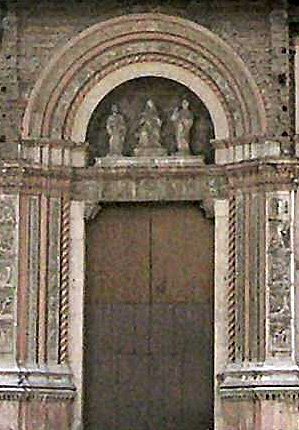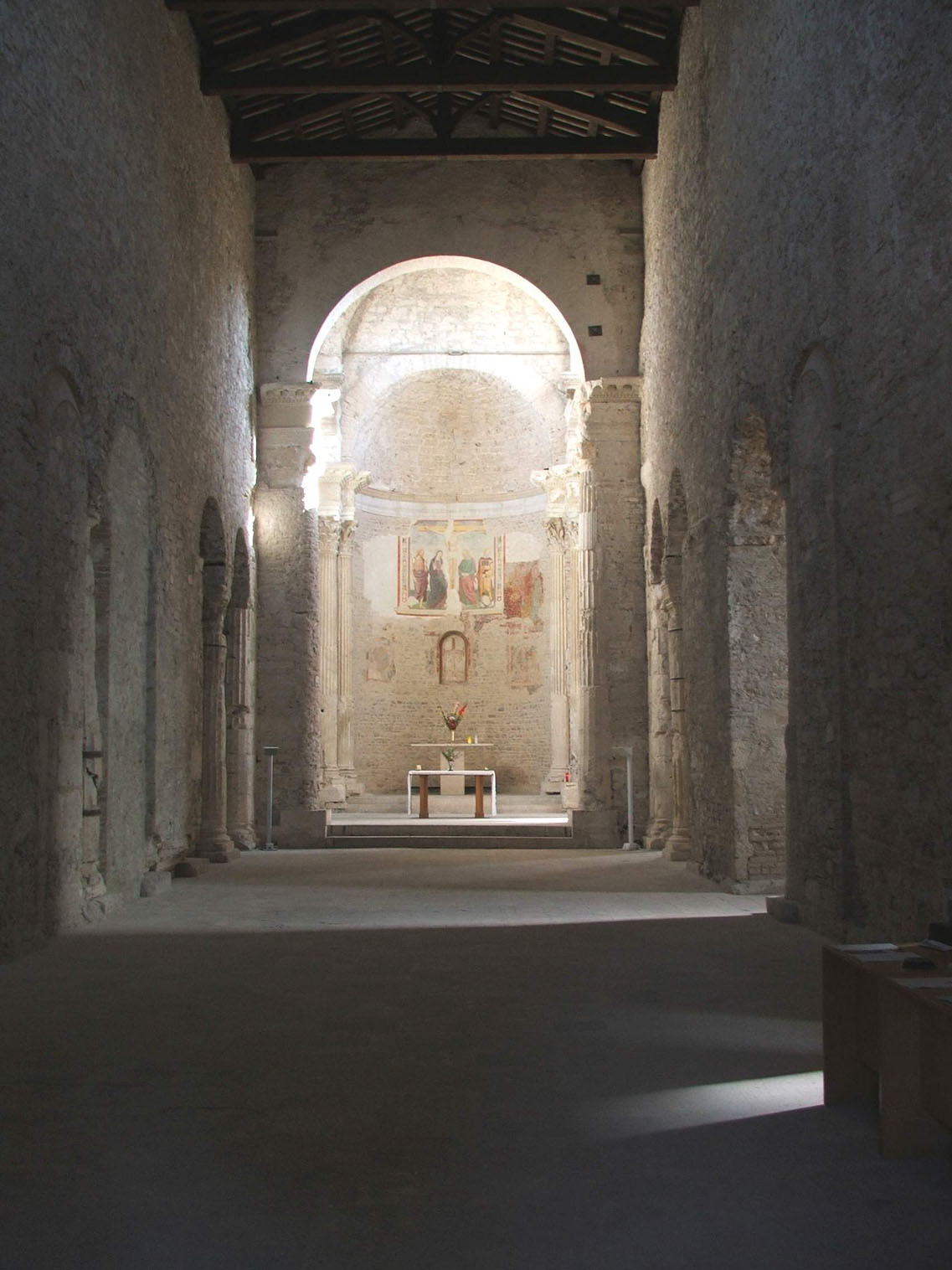|
Antonio Di Vincenzo
Antonio di Vincenzo (1350 − 1401/1402) was an Italian architect, active mainly in his native Bologna in a Gothic style. In 1384, he designed the Palazzo della Mercanzia (Loggia of Merchants) in Bologna, which is built in brick and terracotta. The shrine crowns a pair of arches. The loggia partially collapsed under the bombing of 1943, but was faithfully rebuilt after the War. Its wooden porches of the thirteenth century Seracchioli House, within walking distance of two major towers are commonly photographed. In 1390, Antonio began the construction of the Basilica di San Petronio The Basilica of San Petronio is a minor basilica and church of the Archdiocese of Bologna located in Bologna, Emilia Romagna, northern Italy. It dominates Piazza Maggiore. The basilica is dedicated to the patron saint of the city, Saint Petroniu .... In 1397, Antonio built the second bell tower of the church of San Francesco in a Lombard-style. References 14th-century Italian architects 1 ... [...More Info...] [...Related Items...] OR: [Wikipedia] [Google] [Baidu] |
Bologna
Bologna (, , ; egl, label= Emilian, Bulåggna ; lat, Bononia) is the capital and largest city of the Emilia-Romagna region in Northern Italy. It is the seventh most populous city in Italy with about 400,000 inhabitants and 150 different nationalities. Its metropolitan area is home to more than 1,000,000 people. It is known as the Fat City for its rich cuisine, and the Red City for its Spanish-style red tiled rooftops and, more recently, its leftist politics. It is also called the Learned City because it is home to the oldest university in the world. Originally Etruscan, the city has been an important urban center for centuries, first under the Etruscans (who called it ''Felsina''), then under the Celts as ''Bona'', later under the Romans (''Bonōnia''), then again in the Middle Ages, as a free municipality and later ''signoria'', when it was among the largest European cities by population. Famous for its towers, churches and lengthy porticoes, Bologna has a well-preserved ... [...More Info...] [...Related Items...] OR: [Wikipedia] [Google] [Baidu] |
Gothic Architecture
Gothic architecture (or pointed architecture) is an architectural style that was prevalent in Europe from the late 12th to the 16th century, during the High and Late Middle Ages, surviving into the 17th and 18th centuries in some areas. It evolved from Romanesque architecture and was succeeded by Renaissance architecture. It originated in the Île-de-France and Picardy regions of northern France. The style at the time was sometimes known as ''opus Francigenum'' (lit. French work); the term ''Gothic'' was first applied contemptuously during the later Renaissance, by those ambitious to revive the architecture of classical antiquity. The defining design element of Gothic architecture is the pointed or ogival arch. The use of the pointed arch in turn led to the development of the pointed rib vault and flying buttresses, combined with elaborate tracery and stained glass windows. At the Abbey of Saint-Denis, near Paris, the choir was reconstructed between 1140 and 1144, draw ... [...More Info...] [...Related Items...] OR: [Wikipedia] [Google] [Baidu] |
Palazzo Della Mercanzia
A palace is a grand residence, especially a royal residence, or the home of a head of state or some other high-ranking dignitary, such as a bishop or archbishop. The word is derived from the Latin name palātium, for Palatine Hill in Rome which housed the Roman Empire, Imperial residences. Most European languages have a version of the term (''palais'', ''palazzo'', ''palacio'', etc.), and many use it for a wider range of buildings than English. In many parts of Europe, the equivalent term is also applied to large private houses in cities, especially of the aristocracy; often the term for a large country house is different. Many historic palaces are now put to other uses such as parliaments, museums, hotels, or office buildings. The word is also sometimes used to describe a lavishly ornate building used for public entertainment or exhibitions such as a movie palace. A palace is distinguished from a castle while the latter clearly is fortified or has the style of a fortification ... [...More Info...] [...Related Items...] OR: [Wikipedia] [Google] [Baidu] |
Basilica Di San Petronio
The Basilica of San Petronio is a minor basilica and church of the Archdiocese of Bologna located in Bologna, Emilia Romagna, northern Italy. It dominates Piazza Maggiore. The basilica is dedicated to the patron saint of the city, Saint Petronius, who was the bishop of Bologna in the fifth century. Construction began in 1390 and its main facade has remained unfinished since. The building was transferred from the city to the diocese in 1929; the basilica was finally consecrated in 1954. It has been the seat of the relics of Bologna's patron saint only since 2000; until then they were preserved in the Santo Stefano church of Bologna. History Construction In 1388, the ''Consiglio Generale dei Seicento'' prepared the construction of the church as a civic temple. To make room for the church, the adjacent Curia of Sancti Ambrosii was demolished, together with the majority of one of the city's burgs, including at least eight churches and towers. The first stone of construction was ... [...More Info...] [...Related Items...] OR: [Wikipedia] [Google] [Baidu] |
San Francesco, Bologna
The Basilica of Saint Francis ( it, Basilica San Francesco) is a historic church in the city of Bologna in northern Italy. Founded in the 13th century, it has been the property of the Conventual Franciscan friars since then. The church has been raised to the rank of a Roman Catholic basilica by the Holy See. History The Franciscans had occupied a modest house in the city called Santa Maria delle Pugliole, founded in 1211 by Bernard of Quintavalle, one of the first members of the Order. Their noted founder, St. Francis of Assisi, visited the city in 1222 to preach to the people of the city, which sparked a great interest in the Order he had founded. At the urging of Pope Gregory IX, the authorities of the medieval commune gave the property on which the basilica is now built to the friars in 1236 for a church of their own. It was located in the area of the city known as ''civitas antiqua rupta'' (the old city ruins), where the remains of the Roman city of Bononia were located. Cons ... [...More Info...] [...Related Items...] OR: [Wikipedia] [Google] [Baidu] |
Lombard Architecture
Lombard architecture refers to the architecture of the Kingdom of the Lombards, which lasted from 568 to 774 (with residual permanence in southern Italy until the 10th–11th centuries) and which was commissioned by Lombard kings and dukes. The architectural works of the Lombards in northern Italy (Langobardia Major) have been mostly lost due to later renovations or reconstructions, the few exceptions including the Tempietto longobardo at Cividale del Friuli or the Church of Santa Maria foris portas at Castelseprio. More examples have instead survived in southern Italy ( Langobardia Minor), especially in what was the Duchy of Benevento: they include the city's walls, the church of Santa Sofia and the Rocca dei Rettori, one of the few surviving Lombard military structures, as well as other minor sites near Benevento and in the former duchy of Spoleto. The main surviving examples of Lombard architecture have been included in the Longobards in Italy: Places of Power (568–774 A.D ... [...More Info...] [...Related Items...] OR: [Wikipedia] [Google] [Baidu] |
14th-century Italian Architects
As a means of recording the passage of time Time is the continued sequence of existence and events that occurs in an apparently irreversible succession from the past, through the present, into the future. It is a component quantity of various measurements used to sequence events, to ..., the 14th century was a century lasting from 1 January 1301 (Roman numerals, MCCCI), to 31 December 1400 (Roman numerals, MCD). It is estimated that the century witnessed the death of more than 45 million lives from political and natural disasters in both Europe and the Mongol Empire. West Africa experienced economic growth and prosperity. In History of Europe, Europe, the Black Death claimed 25 million lives wiping out one third of the European population while the Kingdom of England and the Kingdom of France fought in the protracted Hundred Years' War after the death of Charles IV of France, Charles IV, King of France led to a claim to the French throne by Edward III of England, Edwar ... [...More Info...] [...Related Items...] OR: [Wikipedia] [Google] [Baidu] |
1350 Births
135 may refer to: * 135 (number) * AD 135 * 135 BC *135 film 135 film, more popularly referred to as 35 mm film or 35 mm, is a format of photographic film used for still photography. It is a film with a film gauge of loaded into a standardized type of magazine – also referred to as a casse ..., better known as 35 mm film, is a format of photographic film used for still photography * 135 (New Jersey bus) {{numberdis ... [...More Info...] [...Related Items...] OR: [Wikipedia] [Google] [Baidu] |

.jpg)



